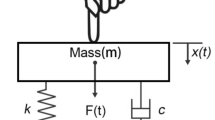Abstract
With various sensors in a smartphone, it is now possible to obtain information about a user and her surroundings, such as the location and the activity of the smartphone user, and the obtained context information is being used to provide new services to the users. In this paper, we propose VibePhone, which uses a built-in vibrator and accelerometer, for efficiently recognizing the type of surfaces contacted by a smartphone, enabling the sense of touch to smartphones. In particular, this paper focuses on developing a succinct set of features that are useful for recognizing surface types for reducing computation and memory requirements, which will in turn reduce the power consumption of the device. For humans and animals, the sense of touch, which is obtained from the texture of an object by scrubbing its surface, is fundamental for both recognizing and learning the properties of objects. Since a smartphone cannot physically scrub the contacting surface, we emulate the touch by generating vibrations and analyzing accelerometer readings. While the recognition of the object type by vibration alone is an extremely difficult task, even for a human, we demonstrate that it is possible to distinguish object types into broad categories where a phone is usually placed. For efficiency, VibePhone uses only a small subset of the most informative features of accelerometer readings using feature selection and reduces the computation time by 92 % using only 15 % of features, while maintaining performance. We believe that our analysis of vibrations about contacted surfaces can provide an important insight for the haptic perception in future smartphones, enabling new experiences to the users.












Similar content being viewed by others
References
Azizyan M, Constandache I, Roy Choudhury R (2009) SurroundSense: mobile phone localization via ambience fingerprinting. In: Proceedings of the International Conference on Mobile Computing and Networking (MobiCom)
Belhumeur P, Hespanha J, Kriegman D (1997) Eigenfaces vs. Fisherfaces: recognition using class specific linear projection. IEEE Trans Pattern Anal Mach Intell 19(7):711–720
Burges CJC (1998) A tutorial on support vector machines for pattern recognition. Data Mining Knowl Discov 2(47):121–167
Canu S, Grandvalet Y, Guigue V, Rakotomamonjy A (2005) SVM and kernel methods matlab toolbox
Cho J, Hwang I, Oh S (2012) Vibration-based surface recognition for smartphones. In: Proceedigns of the International Workshop on Cyber-Physical Systems, Networks, and Applications
Choi SI, Choi CH, Jeong GM (2008) Pixel selection in a face image based on discriminant features for face recognition. In: Proceedings of the International Conference on Automatic Face Gesture Recognition
Consolvo S, McDonald DW, Toscos T, Chen MY, Froehlich J, Harrison B, Klasnja P, LaMarca A, LeGrand L, Libby R, Smith I, Landay JA (2008) Activity sensing in the wild: a field trial of ubifit garden. In: Proceedings of the Conference on Human Factors in Computing Systems (CHI)
Cooley JW, Tukey JW (1965) An algorithm for the machine calculation of complex Fourier series. Math Comput 19(90):297–301
Cover T, Thomas J (1991) Elements of information theory. Wiley, New York
Hsu CW, Lin CJ (2002) A comparison of methods for multiclass support vector machines. IEEE Trans Neural Netw 13(2):415–425
Jolliffe I (2002) Principal component analysis. Springer
Kim Y, Chon Y, Cha H (2012) Smartphone-based collaborative and autonomous radio fingerprinting. IEEE Trans Syst Man Cybern Part C Appl Rev 42(1):112–122
Ko CW, Lee J, Queyranne M (1995) An exact algorithm for maximum entropy sampling. Oper Res 43(4):684–691
Koo J, Cha H (2012) Unsupervised locating of WiFi access points using smartphones. IEEE Trans Syst Man Cybern Part C Appl Rev 99:1–13
Kunze K, Lukowicz P (2007) Symbolic object localization through active sampling of acceleration and sound signatures. In: Proceedings of the International Conference on Ubiquitous Computing (UbiComp)
Kwak N, Choi CH (2002) Input feature selection for classification problems. IEEE Trans Neural Netw 13(1):143–159
Liu DH, Lam KM, Shen LS (2004) Optimal sampling of Gabor features for face recognition. Pattern Recognit Lett 25(2):267–276
Lu H, Pan W, Lane ND, Choudhury T, Campbell AT (2009) SoundSense: scalable sound sensing for people-centric applications on mobile phones. In: Proceedings of the International Conference on Mobile Systems, Applications, and Services (MobiSys)
Lu H, Yang J, Liu Z, Lane ND, Choudhury T, Campbell AT (2010) The Jigsaw continuous sensing engine for mobile phone applications. In: Proceedings of the International Conference on Embedded Networked Sersor Systems (SenSys)
Mizell D (2003) Using gravity to estimate accelerometer orientation. In: Proceedings of the IEEE International Symposium on Wearable Computers
Nemhauser G, Wolsey L, Fisher M (1978) An analysis of the approximations for maximizing submodular set functions—I. Math Program 14:265–294
Nguyen HT, Franke K, Petrovic S (2010) Towards a generic feature-selection measure for intrusion detection. In: Proceedings of the International Conference on Pattern Recognition
Shafer I (2007) Learning location from vibration (2007). http://www.mrcaps.com/proj/LocationVibration/files/vibration-ishafer-paper
Sinapov J, Sukhoy V, Sahai R, Stoytchev A (2011) Vibrotactile recognition and categorization of surfaces by a humanoid robot. IEEE Trans Robot 27(3):488–497
Srinivas N, Krause A, Kakade S, Seeger M (2010) Gaussian process optimization in the bandit setting: no regret and experimental design. In: Proceedings of the International Conference on Machine Learning
Want R, Hopper A, Falcão V, Gibbons J (1992) The active badge location system. ACM Trans Inf Syst (TOIS) 10(12):91–102
Wohlberg B (2003) Noise sensitivity of sparse signal representations: reconstruction error bounds for the inverse problem. IEEE Trans Signal Process 51(12):3053–3060
Acknowledgments
This work was supported by Basic Science Research Program through the National Research Foundation of Korea (NRF) funded by the Ministry of Science, ICT & Future Planning (NRF-2013R1A1A2065551) and by a grant to Bio-Mimetic Robot Research Center funded by Defense Acquisition Program Administration (UD130070ID).
Author information
Authors and Affiliations
Corresponding author
Rights and permissions
About this article
Cite this article
Cho, J., Hwang, I. & Oh, S. VibePhone: efficient surface recognition for smartphones using vibration. Pattern Anal Applic 19, 251–265 (2016). https://doi.org/10.1007/s10044-015-0460-8
Received:
Accepted:
Published:
Issue Date:
DOI: https://doi.org/10.1007/s10044-015-0460-8




